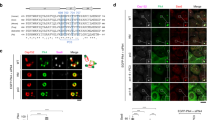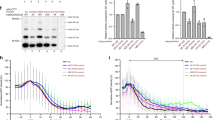Abstract
Organelles called centrosomes in metazoans or spindle pole bodies (SPBs) in yeast direct the assembly of a bipolar spindle that is essential for faithful segregation of chromosomes during mitosis. Abnormal accumulation of multiple centrosomes leads to genome instability, and has been observed in both tumour cells and cells with targeted mutations in tumour-suppressor genes. The defects that lead to centrosome amplification are not understood. We have recapitulated the multiple-centrosome phenotype in budding yeast by disrupting the activity of specific cyclin-dependent kinase (CDK) complexes. Our observations are reminiscent of mechanisms that govern DNA replication, and show that specific cyclin/CDK activities function both to promote SPB duplication and to prevent SPB reduplication.
This is a preview of subscription content, access via your institution
Access options
Subscribe to this journal
Receive 12 print issues and online access
$209.00 per year
only $17.42 per issue
Buy this article
- Purchase on Springer Link
- Instant access to full article PDF
Prices may be subject to local taxes which are calculated during checkout





Similar content being viewed by others
References
Carroll, P. E. et al. Centrosome hyperamplification in human cancer: chromosome instability induced by p53 mutation and/or Mdm2 overexpression. Oncogene 18, 1935–1944 ( 1999).
Fukasawa, K., Choi, T., Kuriyama, R., Rulong, S. & Vande, W. G. Abnormal centrosome amplification in the absence of p53. Science 271, 1744– 1747 (1996).
Xu, X. et al. Centrosome amplification and a defective G2–M cell cycle checkpoint induce genetic instability in BRCA1 exon 11 isoform-deficient cells . Mol Cell 3, 389–395 (1999).
Vidwans, S. J., Wong, M. L. & O'Farrell, P. H. Mitotic regulators govern progress through steps in the centrosome duplication cycle. J. Cell Biol. 147, 1371–1378 (1999).
Matsumoto, Y., Hayashi, K. & Nishida, E. Cyclin-dependent kinase 2 (Cdk2) is required for centrosome duplication in mammalian cells. Curr. Biol. 9, 429–432 (1999).
Hinchcliffe, E. H., Li, C., Thompson, E. A., Maller, J. L. & Sluder, G. Requirement of Cdk2–cyclin E activity for repeated centrosome reproduction in Xenopus egg extracts . Science 283, 851–854 (1999).
Lacey, K. R., Jackson, P. K. & Stearns, T. Cyclin-dependent kinase control of centrosome duplication . Proc. Natl Acad. Sci. USA 96, 2817– 2822 (1999).
Meraldi, P., Lukas, J., Fry, A. M., Bartek, J. & Nigg, E. A. Centrosome duplication in mammalian somatic cells requires E2F and Cdk2–cyclin A. Nature Cell Biol. 1, 88–93 (1999).
Dahmann, C., Diffley, J. F. & Nasmyth, K. A. S-phase-promoting cyclin-dependent kinases prevent re-replication by inhibiting the transition of replication origins to a pre-replicative state. Curr. Biol. 5, 1257– 1269 (1995).
Haase, S. B. & Reed, S. I. Evidence that a free-running oscillator drives G1 events in the budding yeast cell cycle. Nature 401, 394–397 ( 1999).
Follette, P. J., Duronio, R. J. & O'Farrell, P. H. Fluctuations in cyclin E levels are required for multiple rounds of endocycle S phase in Drosophila. Curr. Biol. 8, 235–238 ( 1998).
Weiss, A., Herzig, A., Jacobs, H. & Lehner, C. F. Continuous cyclin E expression inhibits progression through endoreduplication cycles in Drosophila. Curr. Biol. 8, 239 –242 (1998).
Adams, I. R. & Kilmartin, J. V. Localization of core spindle pole body (SPB) components during SPB duplication in Saccharomyces cerevisiae. J. Cell Biol. 145, 809– 823 (1999).
Song, S., Grenfell, T. Z., Garfield, S., Erikson, R. L. & Lee, K. S. Essential function of the polo box of Cdc5 in subcellular localization and induction of cytokinetic structures. Mol. Cell. Biol. 20, 286– 298 (2000).
Fitch, I. et al. Characterization of four B-type cyclin genes of the budding yeast Saccharomyces cerevisiae. Mol. Biol Cell. 3, 805–818 (1992).
Basco, R. D., Segal, M. D. & Reed, S. I. Negative regulation of G1 and G2 by S-phase cyclins of Saccharomyces cerevisiae. Mol. Cell. Biol. 15, 5030–5042 (1995).
Lanker, S., Valdivieso, M. H. & Wittenberg, C. Rapid degradation of the G1 cyclin Cln2 induced by CDK-dependent phosphorylation. Science 271, 1597– 1601 (1996).
Sorger, P. K. & Murray, A. W. S-phase feedback control in budding yeast independent of tyrosine phosphorylation of p34cdc28. Nature 355, 365– 368 (1992).
Amon, A., Tyers, M., Futcher, B. & Nasmyth, K. Mechanisms that help the yeast cell cycle clock tick: G2 cyclins transcriptionally activate G2 cyclins and repress G1 cyclins. Cell 74, 993–1007 (1993).
Richardson, H., Lew, D. J., Henze, M., Sugimoto, K. & Reed, S. I. Cyclin-B homologs in Saccharomyces cerevisiae function in S phase and in G2. Genes Dev. 6, 2021–2034 ( 1992).
Ghiara, J. B. et al. A cyclin B homolog in S. cerevisiae: chronic activation of the Cdc28 protein kinase by cyclin prevents exit from mitosis. Cell 65, 163–174 ( 1991).
Surana, U. et al. Destruction of the CDC28/CLB mitotic kinase is not required for the metaphase to anaphase transition in budding yeast. EMBO J. 12, 1969–1978 ( 1993).
Verma, R. et al. Phosphorylation of Sic1p by G1 Cdk required for its degradation and entry into S phase. Science 278, 455 –460 (1997).
Noton, E. & Diffley, J. F. CDK inactivation is the only essential function of the APC/C and the mitotic exit network proteins for origin resetting during mitosis. Mol. Cell 5, 85–95 (2000).
Adams, I. R. & Kilmartin, J. V. Spindle pole body duplication: a model for centrosome duplication? Trends Cell Biol. 10, 329–335 ( 2000).
Byers, B. & Goetsch, L. Preparation of yeast cells for thin-section electron microscopy. Methods Enzymol. 194, 602–608 (1991).
Wittenberg, C., Sugimoto, K. & Reed, S. I. G1-specific cyclins of S. cerevisiae : cell cycle periodicity, regulation by mating pheromone, and association with the p34CDC28 protein kinase. Cell 62, 225–237 (1990).
Acknowledgements
We thank I. Adams for the Spc42–GFP construct pIA29, and J. Kilmartin for initial electron-microscopic observations. We also thank M. Watson, N. Rhind, T. T. Su and M. Morris for critical reviewing of the manuscript, M. Wolff for technical assistance, and M. Wood, A. Sanusi and T. H. Giddings Jr for electron-microscopic work. This work was supported by NIH grant nos GM38328 (to S.I.R.) and GM51312 (to M.W).
Author information
Authors and Affiliations
Corresponding author
Rights and permissions
About this article
Cite this article
Haase, S., Winey, M. & Reed, S. Multi-step control of spindle pole body duplication by cyclin-dependent kinase. Nat Cell Biol 3, 38–42 (2001). https://doi.org/10.1038/35050543
Received:
Revised:
Accepted:
Published:
Issue Date:
DOI: https://doi.org/10.1038/35050543
This article is cited by
-
A transcriptome-wide analysis deciphers distinct roles of G1 cyclins in temporal organization of the yeast cell cycle
Scientific Reports (2019)
-
Regulated inactivation of the spindle assembly checkpoint without functional mitotic spindles
The EMBO Journal (2011)
-
Prognostic relevance of Centromere protein H expression in esophageal carcinoma
BMC Cancer (2008)
-
Global control of cell-cycle transcription by coupled CDK and network oscillators
Nature (2008)
-
Multiple levels of cyclin specificity in cell-cycle control
Nature Reviews Molecular Cell Biology (2007)



